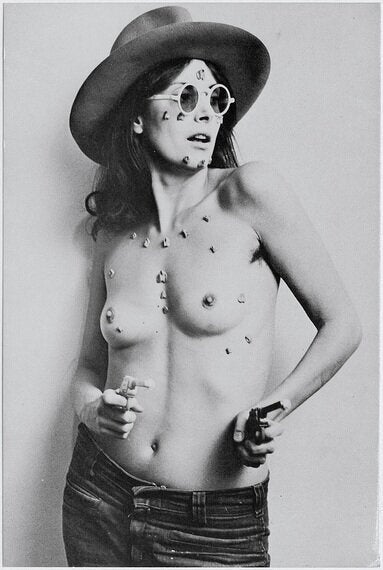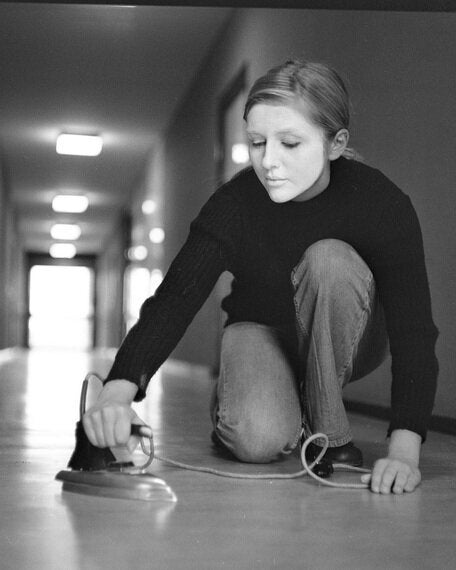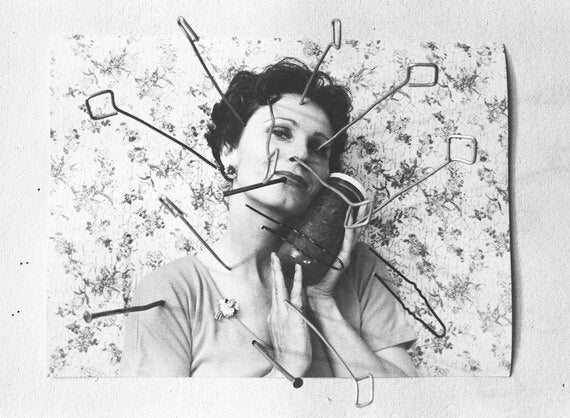
I wish I could take you all by the hand and give you a guided tour of this show. If I could, honestly I would because, simply, I can't remember the last time I was so inspired by a photography show. At every point in this impressive exhibition, I felt galvanized and emboldened. If, like me, you are a tired feminist, wounded and depressed from years of battle, this is a show that will put the fire back into your veins.
The exhibition itself is vast in content - there are over two hundred works of art on display here from forty-eight artists. It's of such a size that it takes over two floors in the Gallery. But more than this, the works tackle big themes. It's all here, from representation of the female form, ownership, domesticity and sexuality, to violence and female identity.
And don't for a second think that somehow because these are female artists directly tackling cultural issues that, in some way, these are lesser works. No way. We'll have none of that casual misogyny here, thank you. This was a period of creation and innovation, as well as protest, and that is ably represented here.
There are big names, of course. I knew I was going to love seeing more photographs from Francesca Woodman; I could immerse myself in her haunting works for hours. And the likes of Cindy Sherman, ORLAN and Hannah Wilke are well represented with some of their more iconic images. And there's one of the most famous feminist works on display too with Martha Rosler's masterful A-Z of domesticity and violence, Semiotics of the Kitchen, running on loop. And after seeing some of Alexis Hunter's work at Tate Britain, it's great to see more of her 'burn it all down' style here.

But one of the real pleasures in the show is seeing more from less familiar names.
I was particularly drawn to video footage of performance art pieces from Suzanne Lacy and Leslie Labowitz. In the last few years of the 1970s, these two women collaborated on a series of large-scale public actions in LA addressing violence against women, and the sensationalism and sexualisation of many of the victims of the Hillside Strangler, a serial killer who raped and murdered many women in the city at the time.
Male violence against women remains prolific today - as does the media frenzy in sexualising and eroticising these crimes - and as I watched the footage of these powerful performances where performance meets protest - a stream of anonymous women shrouded in black parading through public squares - I thought, where are these protests today? Is it time to bring back feminist performance art? Is this a way to relight those fires?
In fact, for all the impressive photography on show, it is the film in this exhibition which is its most surprising highlight. Lydia Schouten's Sexobject is another example of this. Here, Lydia has strapped herself into a web of bondage ropes; in front of her a wall with 'how does it feel to be a sex object' graffitied across it. And Lydia whips this wall again and again, tiring noticeably with every single strike.

That these artists should seek to include so much of themselves in their works should not be a surprise. Just showing yourself and your body as it really is is, for women, a mighty political act. And there is nothing in this world more politicised than the female body - men seek both to desire and control it, legislation exists to restrict the autonomy women have over it. It is both a means for creating new life and a prison that it is impossible to escape.
It would be possible to write a piece about each work, such is the depth of quality in this display. However, not only would no one ever read all those articles I would write (and I'm not sure where I would find the time to do it!) but I would much rather you visited the show, explored it and connected with those pieces that resonate the strongest with you.
Suffice to say that The Photographers' Gallery has curated a terrific show that demonstrates how fertile this era was for female artists and their willingness and ability to use their work to engage on gender roles and sexual politics. It was a ground-breaking time but it also ably demonstrates the power that art can have, and the role it can play in not just tackling issues but shaping the discourse around them too. Provocative stuff? Absolutely. Pioneering works? Unquestionably. Could we do another wave of this for the 21st century? Hell, yes.
The Photographers' Gallery, London, to January 15, 2017
Admission £4 (free before 12 noon)
Image credits:
1 Hannah Wilke S.O.S. Starification Object Series. One of 36 playing cards from mastication box, 1975 Post card Hannah Wilke Collection & Archive, Los Angeles. © Marsie, Emanuelle, Damon, and Andrew Scharlatt /Bildrecht, Vienna, 2015 / SAMMLUNG VERBUND,Vienna
2 Renate Eisenegger Hochhaus (Nr.1), 1974 © Renate Eisenegger / SAMMLUNG VERBUND, Vienna
3 Karin Mack Zerstörung einer Illusion, 1977 © Karin Mack / SAMMLUNG VERBUND, Vienna